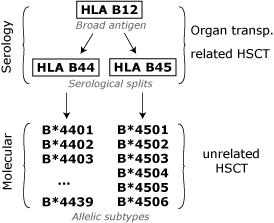| Typing strategy and choice of the method in organ transplantation | ||
Tissue typing remains a compromise between the quest for a full characterization of all HLA alleles of the patient and of the potential donor(s) and the resources available in the routine tissue-typing laboratory. In many cases, HLA typing can be limited to the determination of HLA-ABDR. HLA alleles are inherited in a strong linkage disequilibrium and donors identical for HLA-ABDR have a fair chance of being compatible for HLA-C, HLA-DQ as well. HLA class I typing can be either performed by serology or by DNA-typing, the latter being the preferred method for class II typing. The level of resolution (sensitivity) required is clearly the key determining the choice of the methodology. The senstivity (low, intermediate, high) required varies according to the clinical setting, i.e organ or HSC transplantation and to the relationship between the patient and the potential donor. In organ transplantation, low resolution typing such as serology or PCR-SSP is sufficient because the probability of finding an available HLA-matched organ is very low. Read more about HLA typing and techniques |
